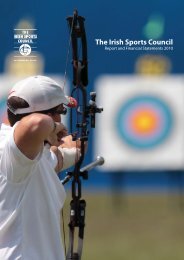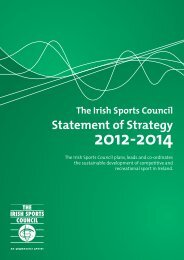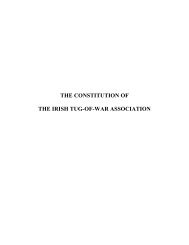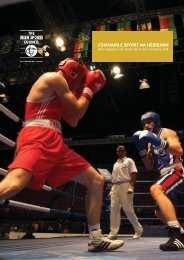Strategic Planning Guidelines - The Irish Sports Council
Strategic Planning Guidelines - The Irish Sports Council
Strategic Planning Guidelines - The Irish Sports Council
You also want an ePaper? Increase the reach of your titles
YUMPU automatically turns print PDFs into web optimized ePapers that Google loves.
Step 1: Plan the Plan<br />
Before the work of actually producing the plan can really start, a number of key decisions<br />
have to be taken. <strong>The</strong>se decisions will affect the eventual outcome, so they require<br />
careful consideration:<br />
• <strong>The</strong> composition of the “planning team”: the last section suggested the creation of a<br />
team to oversee the planning process. This should be a group of no more than about<br />
half a dozen people – more than this and it can be very difficult to arrange meetings –<br />
who are committed to the long term good of the NGB. Ideally, they should have no<br />
personal axes to grind: they are on the planning team to represent the area as a whole,<br />
not a particular interest group/sport.<br />
• How the plan is going to be prepared: at the outset it is important to determine<br />
whether the plan preparation is to be done completely “in-house” or will involve an<br />
external facilitator and the broad approach to be adopted. This guide is intended as a<br />
template, which NGBs can adapt to their own particular needs.<br />
• Identify key internal stakeholders: NGBs have a number of internal stakeholders<br />
who will be affected directly by the planning process and outcomes of the plan.<br />
<strong>The</strong>se will include:<br />
� <strong>The</strong> NGB’s partners<br />
� Its members<br />
� Professional staff: NGB staff is likely to be affected by the preparation of a<br />
strategic plan. Staff must be included in the process, otherwise might gain the<br />
impression the plan is being prepared behind her/ his back.<br />
� Others (this is dependent on specific NGB circumstances)<br />
• Decide on the key external stakeholders: NGBs also have external stakeholders –<br />
the organisations with which they interact such as clubs, sponsors, the <strong>Irish</strong> <strong>Sports</strong><br />
<strong>Council</strong> and Government Departments. In addition, if there are outside organisations<br />
with which the NGB is likely to wish to work in partnership, it will often help to bring<br />
them in to the planning process. In many instances external stakeholders will not<br />
wish to be involved on an ongoing basis but this does not mean they should be<br />
ignored.<br />
• Set a broad timetable for the planning process: preparing a strategic plan nearly<br />
always takes longer than expected at the outset, so build some “float” time into any<br />
programme for the preparation of a plan. When setting the overall programme, the<br />
key dates on which to base the plan timetable are usually:<br />
� <strong>The</strong> end of the financial year: the best time to start implementing a new strategic<br />
plan is at the beginning of an ISC funding year. This allows an existing budget to<br />
continue while the plan and related new budget are prepared<br />
� When the NGB has to submit its plan to the <strong>Irish</strong> <strong>Sports</strong> <strong>Council</strong>. Any deadline set<br />
by the <strong>Council</strong> will obviously be a critical date to take into account when planning<br />
16

















